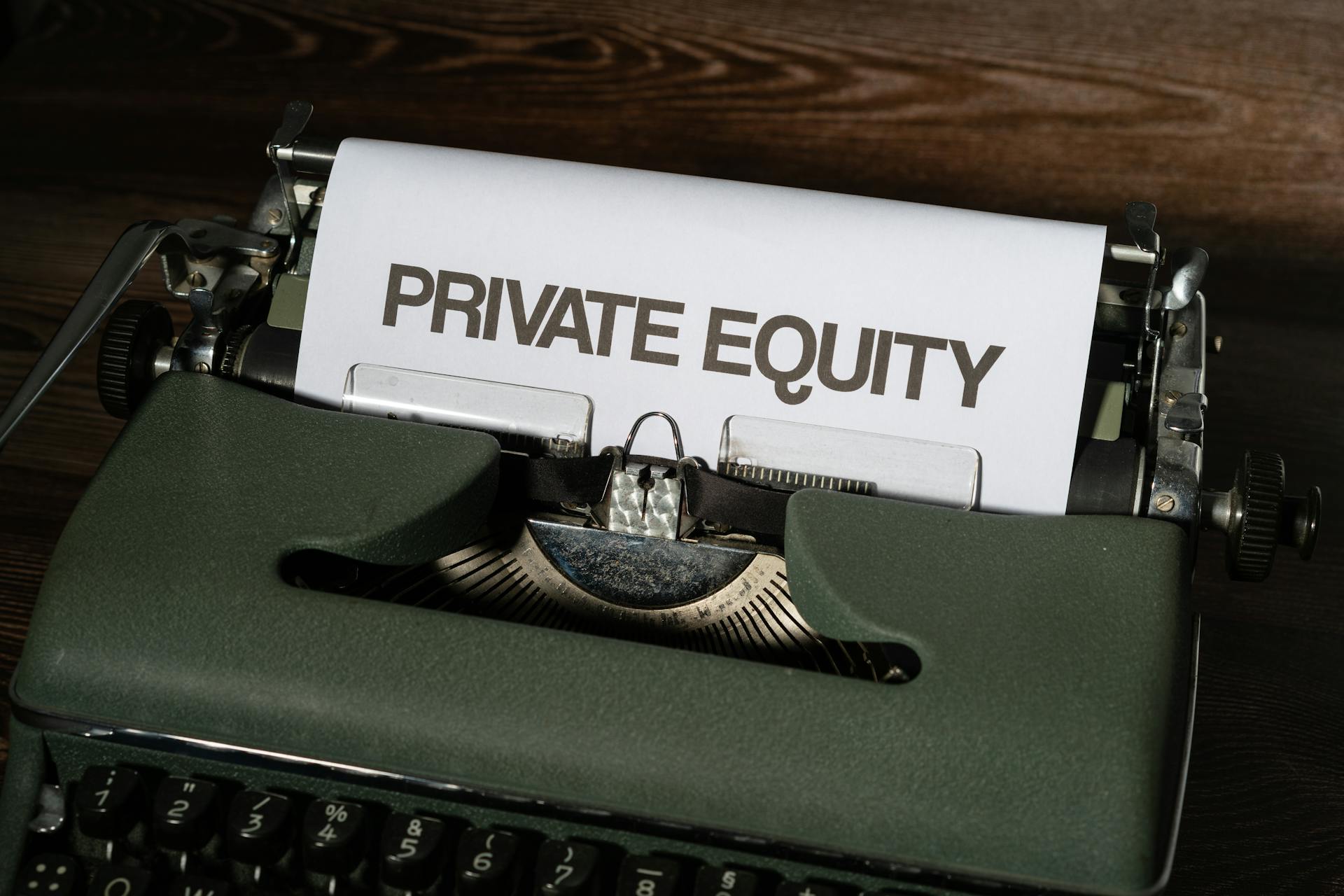
Secondary sale private equity investment strategies and opportunities offer a unique way for investors to tap into the private equity market.
Secondary sales can be a more efficient way to invest in private equity, as they allow investors to bypass the fundraising process and directly acquire existing fund interests.
Secondary sales can also provide a way for investors to gain exposure to a broader range of private equity funds and strategies.
Investors can consider secondary sales as a way to diversify their portfolio and gain access to new investment opportunities.
Investors should be aware that secondary sales often come with a premium, which can be a disadvantage in certain market conditions.
You might enjoy: Harley Finance Private Sales
What is Secondary Sale Private Equity
Secondary sale private equity refers to the sale of shares in a private company that were initially acquired through a primary transaction. This can happen when an investor wants to exit their investment in a private company.
See what others are reading: Secondary Sale
The process of secondary sale private equity is quite different from the public markets. For instance, transactions on private markets take much longer to complete, often involving price negotiation, due diligence, and rights transfer.
One of the key challenges in secondary sale private equity is information asymmetry, where the buyer may not have access to the same level of information as the seller. This can make it difficult for buyers to make informed decisions.
In contrast, secondary transactions on public markets have greater information symmetry, with buyers and sellers having access to similar levels of information.
Here are some key differences between secondary transactions on public and private markets:
- Fast transaction times on public markets vs slower transaction times on private markets
- Higher liquidity on public markets vs low liquidity on private markets
- Greater information symmetry on public markets vs information asymmetry on private markets
The Market and Trends
The secondary private equity market has grown rapidly over the past decade, reaching a record $132 billion in 2021, more than five times its previous size.
This growth is largely driven by the increasing demand from Limited Partners (LPs), who are investors that commit capital to funds. In the first half of 2022, LPs accounted for 58% of market volume, with $33 billion in transactions.
The share of deals led by General Partners (GPs) is rising, however, and reached $24 billion in the first half of 2022, accounting for 42% of market volume. This increase in GP-led transactions is a notable trend in the market.
Global secondary volume in the first half of 2022 was $57 billion, surpassing the prior first-half record of $48 billion in 2021. This record level of secondary volume was driven by strong buy-side demand and thoughtful portfolio construction.
Interest in the secondary private equity market is increasing from both investors and private equity funds. The need for creative liquidity solutions outside traditional routes is also growing, particularly in tougher economic conditions.
With the widening of discounts, secondaries may be an opportunity for investors to make cheap additional investments in private equity. This could lead to increased competition in the market as many investors are still looking to expand their private equity allocations.
Recommended read: Venture X Charlotte - the Refinery
Key Factors and Considerations
The global secondary market is expected to grow to over $130 billion in 2023, driven by factors such as growing allocations to venture capital, extended time horizons for startup exits, increased investor demand for liquidity, and the proliferation of new secondary deal structures.
Secondary investors should conduct thorough due diligence to mitigate potential informational gaps and risks associated with early-stage investments. This process can involve gathering information from the primary investor and other stakeholders.
Private equity firms buy companies and overhaul them to earn a profit when the business is sold again, often using capital from outside investors and supplemented by debt. The private equity industry has grown rapidly and tends to be most popular when stock prices are high and interest rates low.
The key benefits of private equity secondaries include providing liquidity for existing investors, offering cheaper prices due to forced sellers, giving GPs an approved continuation vehicle, allowing for more due diligence, providing diversification, and offering faster returns.
You might like: Liquidity and Working Capital Management
Some key factors to consider before investing in private equity secondaries include the complexity of valuing secondary assets, risks associated with management continuity, and potential for lower returns. It's essential to understand the nuances of each deal, valuation metrics, and market dynamics to make informed decisions.
A key advantage of secondary deals is the potential for discounts, with buyers often obtaining discounts over latest valuations of between 5% and 15%. Secondary investors also benefit from improved returns, shorter time to exits, removal of early-stage risk, lower transaction minimums, and more time for due diligence.
Here are some key factors to consider when evaluating private equity secondaries:
- Valuation Complexity: Determining the fair market value of secondary assets can be complex due to the lack of publicly available pricing information.
- Management Continuity Risks: Changes in management or strategy can affect the underlying assets' performance.
- Potential for Lower Returns: Secondary assets may carry the risk of lower returns due to being nearer to maturity and having already passed some of the highest growth phases.
Deal Types and Structure
Private equity deals can be categorized into several types, including buyouts, carve-outs, and secondary buyouts. A buyout involves the acquisition of an entire company, while a carve-out is the purchase of a division of a larger company. Secondary buyouts, on the other hand, involve a private equity firm buying a company from another private equity group.
Expand your knowledge: Corporate Carve Out Private Equity
Carve-outs can be complex and riskier, but often fetch lower valuation multiples. For example, Carlyle's acquisition of Tyco Fire & Security Services Korea Co. Ltd. from Tyco International Ltd. in 2014 was a carve-out. In contrast, secondary buyouts can be more common, as private equity firms increasingly specialize in buying and selling companies.
There are also two types of private equity secondary transactions: those led by a limited partner (LP) and those led by a general partner (GP). LP secondary transactions are the most common, involving an existing LP selling its assets to a secondary buyer.
If this caught your attention, see: Byd Company Limited Investor Relations
Deal Types
Private equity firms make deals to buy and sell their portfolio companies, which can be categorized into different types.
A buyout is a staple of private equity deals, involving the acquisition of an entire company, whether public, closely held or privately owned.
Private equity investors acquiring an underperforming public company will often seek to cut costs and restructure its operations.
Intriguing read: Investor Relations and Public Relations
Carve-outs are another type of private equity acquisition, where private equity investors buy a division of a larger company, typically a non-core business put up for sale by its parent corporation.
Carve-outs tend to fetch lower valuation multiples than other private equity acquisitions but can be more complex and riskier.
Secondary buyouts are exit strategies in private equity where the investment is sold to another financial sponsor.
There are two types of secondary private equity transactions: direct investor purchases and fund interest purchases.
Direct investor purchases involve the secondary investor purchasing equity directly from a primary investor.
Fund interest purchases involve the buyer taking over a limited partnership interest in a private equity fund from an existing LP.
Secondary transactions generally fall into two main categories: limited partner (LP) secondaries and general partner-led (GP-led) secondaries.
LP secondary transactions are the most common, occurring when an existing LP sells its assets to a secondary buyer.
GP-led secondary transactions involve the GP forming a new continuation fund to acquire assets from a predecessor fund.
GP-led secondary transactions can offer attractive benefits in all market conditions by allowing the flexibility for GPs to hold their most promising assets longer and providing added exit options.
Sponsor-to-sponsor deals, or secondary buyouts, can be a convenient exit strategy for sellers due to their quick closing times.
The seller might take a risk-averse approach by exiting the investment, even if it means returns are less than their fund’s target returns profile.
A unique perspective: Coller Secondaries Private Equity Opportunities Fund
PE Investing with IRA Funds
Investing in private equity (PE) can be a high-growth asset class, but it often requires significant funds.
Many investors may not have the necessary funds, but they can tap into their 401(k) or IRA funds through a self-directed IRA (SDIRA).
A SDIRA is identical to a traditional IRA, but it allows for investments in assets the IRS allows, including private equity.
Thousands of Entrust clients have invested their retirement funds in private equity, pairing tax-advantaged growth with high-growth potential.
Investors can gain exposure to private equity assets through private equity secondaries, which offer a potential exit before the full duration of the original investment term.
Private equity secondaries can also provide a shorter lock-up period in exchange for lower growth potential.
Investors who are concerned about extended hold-up periods and potential implications on required minimum distributions (RMDs) may find private equity secondaries a compelling solution.
Benefits and Challenges
Secondary sale private equity offers a range of benefits and challenges that investors should be aware of.
One of the key benefits is liquidity for existing investors. Secondary markets provide a way for investors to exit their investments before the fund's completion, which can be a major advantage.
Another benefit is the potential for discounted purchases. Secondary investments can often be acquired at a discount to their net asset value (NAV), which can enhance the return on investment.
Forced sellers create cheaper prices, which is one of the largest appeals to new investors. This discount can potentially make secondary investments more attractive.
GP-led secondaries allow GPs to avoid selling down when they might not want to via an investment vehicle that LPs trust. This can be beneficial for GPs who want to maintain control over their investments.
Secondaries give buyers already know what's in the portfolio, unlike the black box that often represents investing in private equity funds. This allows for more in-depth due diligence and can reduce the risk of investing.
However, there are also potential drawbacks to PE secondaries. Illiquidity is one of the major challenges, as private equity is intrinsically illiquid compared to public assets.
Readers also liked: Corporate Bonds Most Often Pay Interest
Complex valuation is another challenge in the secondary market. Companies' valuations can be challenging to determine, and the assets' actual value may differ from the price paid.
Uneven cash flows are also a challenge in the secondary market. The cash flow profile depends on distributions, making it essential to choose experienced managers who have a keen eye on down-market protection.
Here are some of the key benefits and challenges of secondary sale private equity:
Management and Regulation
Private equity fund managers are subject to regulations, but their funds themselves are exempt from SEC oversight. This means that private equity firms are not directly regulated by the SEC, but their managers must still comply with certain laws.
The Investment Advisers Act of 1940 and anti-fraud provisions of federal securities laws apply to private equity fund managers. This is a key distinction between private equity firms and other types of investment companies.
In February 2022, the SEC proposed new rules that would require private fund advisers to provide clients with quarterly statements detailing fund performance, fees, and expenses.
Funds Management
In a private equity fund, the general partner (GP) is responsible for making all management decisions. The GP is usually the private equity firm that established the fund.
The GP contributes 1% to 3% of the fund's capital to ensure they have a personal stake in the fund's performance. This is known as having "skin in the game".
The GP earns a management fee of 2% of the fund's assets. This fee is a regular payment made to the GP for their management services.
The GP may also be entitled to 20% of the fund's profits above a preset minimum as incentive compensation, known as carried interest. This is a way to motivate the GP to make good investment decisions.
On a similar theme: Capital Budgeting Decisions Include
Are Firms Regulated?
Private equity firms are subject to some level of regulation, although it's not as strict as you might think.
Their managers are required to adhere to the Investment Advisers Act of 1940 and the anti-fraud provisions of federal securities laws.
In February 2022, the SEC proposed new rules that would require private fund advisers to provide clients with quarterly statements detailing fund performance, fees, and expenses.
Private fund advisers would also need to obtain annual fund audits and disclose any preferential terms given to one client in an investment vehicle to the other investors in the same fund.
Private equity funds themselves are exempt from regulation by the SEC under the Investment Company Act of 1940 and the Securities Act of 1933.
Performance and Returns
Secondary buyouts often exhibit lower fund returns, with most private equity firms viewing them as a less desirable exit.
Historical data shows that secondary buyouts tend to generate lower returns compared to other exit strategies.
In fact, there is substantial evidence supporting the claim that secondary buyouts exhibit lower fund returns.
Learn from the experiences of other investors who have navigated secondary buyouts and understand the potential risks and rewards.
Expand your knowledge: Venture Capital Fund Returns
Exit and Liquidity
In the secondary sale private equity market, exit and liquidity are crucial factors that drive the supply of shares. The average time to M&A or IPO is 6.6 and 7.5 years, respectively, meaning primary investors look towards the secondary market for an exit on their investment.
Institutional investors and employees are the primary sources of supply in the secondary market. Institutional investors use the secondary market to exit their investments, while employees use Employee Share Options Plans (ESOP) to liquidate their shares. Employees may find themselves sitting on significant wealth through vested shares, making the secondary market an attractive option for them to monetize their shares.
The liquidity premium in the secondary market is evident in the discount sellers typically offer on the market. According to a study, the average discount over Net Asset Value (NAV) was 13.8%, but more recent data shows the median discount value has essentially disappeared, and the mean now stands at 2%. This indicates demand for secondary deals might be rising faster than supply.
If this caught your attention, see: Supply Chain Finance
Here are the main factors driving supply in the secondary market:
- Portfolio rebalancing: Funds may need to sell shares to maintain their desired asset allocation ratios due to rising valuations.
- Private equity capital generation: GPs may monetize their stake in portfolio companies to generate cash distributions to their LPs.
- Desire for diversification: Investors may wish to reduce their risk exposure to private equity, and employees may want to diversify their wealth.
Exit Strategies
As you navigate the exit and liquidity process, it's essential to understand the various strategies available to private equity firms. There are three primary exit options, each with its unique characteristics.
A strategic buyer is typically the quickest way to exit an investment, fetching higher valuations due to potential synergies. This option is often the most time-efficient.
The next option is a secondary buyout, also known as a "sponsor-to-sponsor" deal. In this scenario, a portfolio company is sold to another private firm, which can be more competitive in pricing due to the absence of synergies.
Here are the three exit options in a nutshell:
- Sale to Strategic: Quick and fetching higher valuations
- Secondary Buyout: More competitive pricing, but no synergies
- Initial Public Offering (IPO): Exclusive to top-tier firms and mega-funds
An IPO exit is relatively rare, limited to top-tier private firms operating in the upper middle market, often via club deals.
Liquidity Needs
Institutional investors are a primary source of supply for the secondary market, with an average time to M&A or IPO of 6.6 and 7.5 years, respectively, meaning they look towards the secondary market for an exit on their investment.
Employees also contribute to the supply of shares in the secondary market, particularly those with vested shares through Employee Share Options Plans (ESOPs). Startups often use ESOPs to hire and retain staff, resulting in employees sitting on significant wealth that they can monetize through the secondary market.
The need for liquidity is the primary driver of secondary private equity deals, with a liquidity premium manifesting as a discount on sale prices. According to a study, the average discount over Net Asset Value (NAV) was 13.8%, although more recent data shows the median discount value has essentially disappeared, with a mean discount of 2%.
Here are some key statistics on the liquidity premium:
This indicates that demand for secondary deals might be rising faster than supply.
Frequently Asked Questions
What is the difference between primary and secondary deals in private equity?
Primary deals involve investing directly into a private equity fund, while secondary deals involve buying existing fund interests from other investors, typically with faster cash returns but at a higher purchase price
Sources
- https://insights.alta.exchange/a-guide-to-secondary-private-equity-market-opportunities/
- https://www.wallstreetprep.com/knowledge/secondary-buyout-sbo/
- https://www.investopedia.com/terms/p/privateequity.asp
- https://www.eisneramper.com/insights/financial-services/private-equity-secondaries-benefits-and-challenges-1124/
- https://www.theentrustgroup.com/blog/private-equity-secondaries
Featured Images: pexels.com


